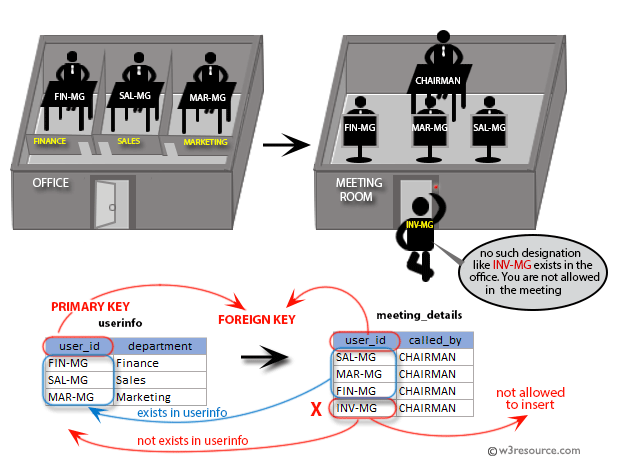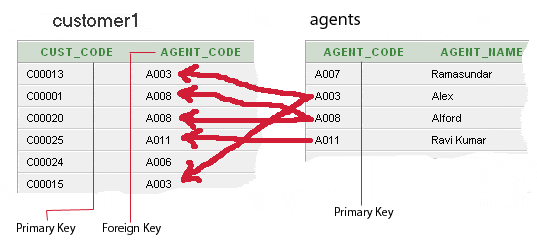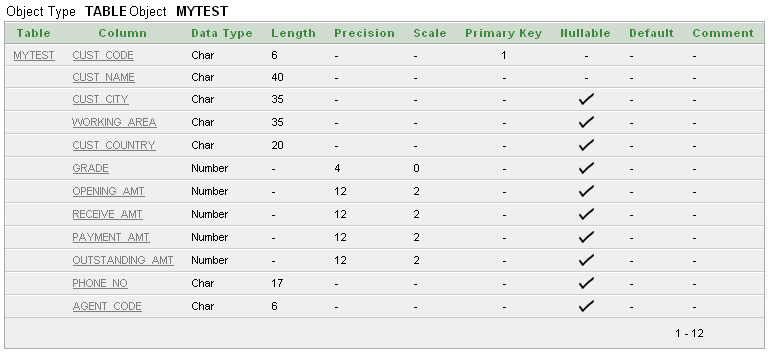SQL FOREIGN KEY
FOREIGN KEY
The SQL FOREIGN KEY CONSTRAINT is used to ensure the referential integrity of the data in one table to match values in another table.
The FOREIGN KEY CONSTRAINT is a column or list of columns which points to the PRIMARY KEY of another table.
The main purpose of FOREIGN KEY is, only those values will appear which are present in the primary key table.

For each row in the referencing table( the table contains the FOREIGN KEY), the foreign key must match an existing primary key in the referenced table(the table contains the PRIMARY KEY). This enforcement of FOREIGN KEY called the Referential Integrity.
The structure and data type of PRIMARY KEY and FOREIGN KEY must be same.
The values of the FOREIGN KEY columns in each row of the referencing table have to match with the values of the corresponding primary key columns of a row in the referenced table.
Syntax:
CREATE TABLE <table_name>( column1 data_type[(size)] , column2 data_type[(size)] , constraint(constraint_name) FOREIGN KEY [column1,column2...] REFERENCES [primary_key_table] (column_list_of_primary_key_table) ...);
Parameters:
| Name | Description |
|---|---|
| table_name | The name of the table where data is stored. |
| column1,column2 | Name of the columns of a table. |
| data_type | Is char, varchar, integer, decimal, date and more. |
| size | Maximum length of the column of a table. |
| constraint | Is a key word. This key word is optional. |
| constraint_name | Is a constraint name defined by user. |
| primary_key_table | Table where primary key resides. |
| column_list_of_primary_key_table | List of columns which makes primary key for a table. |
Example:
Suppose, we have a table 'agents', that includes all agents data, and we are going to create another table named 'customer1', that includes all customers records. The columns and data types for both the tables have shown bellow.
The constraint here is that all customers must be associated with an agent that is already in the 'agents' table. In this case, an SQL FOREIGN KEY CONSTRAINT should be created with the 'customer1' table which is related to the SQL PRIMARY KEY CONSTRAINT of the 'agents' table.
Now, we can ensure that all customers in the 'customer1' table are related to an agent in the 'agents' table. In other words, the 'customer1' table can not contain information of any agent who is not on the 'agents' table.
agents
| Field Name | Data Type | Size | Decimal Places | NULL | Constraint |
|---|---|---|---|---|---|
| agent_code | char | 6 | No | PRIMARY KEY | |
| agent_name | char | 40 | No | ||
| working_area | char | 35 | Yes | ||
| commission | decimal | 10 | 2 | Yes | |
| phone_no | char | 17 | Yes |
customer1
| Field Name | Data Type | Size | Decimal Places | NULL | Constraint |
|---|---|---|---|---|---|
| cust_code | char | 6 | No | PRIMARY KEY | |
| cust_name | char | 25 | Yes | ||
| cust_city | char | 25 | Yes | ||
| agent_code | char | 6 | Yes | FOREIGN KEY |
the following SQL statement can be used :
SQL Code:
CREATE TABLE customer1(
cust_code char(6) NOT NULL PRIMARY KEY,
cust_name char(25),
cust_city char(25),
agent_code char(6),
FOREIGN KEY(agent_code)
REFERENCES agents (agent_code)
) ;
Pictorial representation

SQL CREATE TABLE with FOREIGN KEY in column constraint
In the following topic, we are going to discuss the usage of FOREIGN KEY CONSTRAINT without using the 'foreign key' keyword.
Example:
To create a table which contains the following field names and data types.
| Field Name | Data Type | Size | Decimal Places | NULL | Constraint |
|---|---|---|---|---|---|
| cust_code | char | 6 | No | PRIMARY KEY | |
| cust_name | char | 25 | Yes | ||
| cust_city | char | 25 | Yes | ||
| agent_code | decimal | 6 | Yes |
The table contains a PRIMARY KEY CONSTRAINT on 'cust_code' and a FOREIGN KEY on 'agent_code' without using the FOREIGN KEY key word.
The 'agent_code' in 'agents' table are unique.
Only those 'agent_code' which are present in 'agents' table will appear in 'mytest' table because reference column is 'agent_code' of 'agents' table.
the following SQL statement can be used :
SQL Code:
CREATE TABLE mytest(
cust_code char(6) NOT NULL PRIMARY KEY,
cust_name char(25),
cust_city char(25),
agent_code char(6)
REFERENCES agents(agent_code));
To see the structure of the created table:
SQL Code:
DESCRIBE mytest;
Output:

SQL CREATE TABLE using FOREIGN KEY CONSTRAINT without specifying PRIMARY KEY column(s)
In the following topic, we are going to discuss, how FOREIGN KEY CONSTRAINT can be used without specifying the primary key column(s).
Example:
To create a table containing the following field names and data types:
| Field Name | Data Type | Size | Decimal Places | NULL | Constraint |
|---|---|---|---|---|---|
| cust_code | char | 6 | No | PRIMARY KEY | |
| cust_name | char | 25 | Yes | ||
| cust_city | char | 25 | Yes | ||
| agent_code | decimal | 6 | Yes |
The table contains a PRIMARY KEY CONSTRAINT on 'cust_code' and a FOREIGN KEY on 'agent_code' without specifying the PRIMARY KEY column -
The 'agent_code' in 'agents' table are unique.
Only those 'agent_code' which are present in 'agents' table will appear in 'mytest' table because reference column is 'agent_code' of 'agents' table.
the following SQL statement can be used:
SQL Code:
CREATE TABLE mytest(
cust_code char(6) NOT NULL PRIMARY KEY,
cust_name char(25),
cust_city char(25),
agent_code char(6)
REFERENCES agents);
To see the structure of the created table:
SQL Code:
DESCRIBE mytest;
Output:

SQL CREATE TABLE using FOREIGN KEY CONSTRAINT with PRIMARY KEY column list
In the following topic, it is going to be discussed that, how SQL FOREIGN KEY CONSTRAINT is used with primary key column list in a CREATE TABLE statement.
Example:
To create a table which contains the following field names and data types -
| Field Name | Data Type | Size | Decimal Places | NULL | Constraint |
|---|---|---|---|---|---|
| cust_code | char | 6 | No | PRIMARY KEY | |
| cust_name | char | 40 | No | ||
| cust_city | char | 35 | Yes | ||
| working_area | char | 35 | Yes | ||
| cust_country | char | 20 | Yes | ||
| grade | decimal | 4 | 0 | Yes | |
| opening_amt | decimal | 12 | 2 | Yes | |
| receive_amt | decimal | 12 | 2 | Yes | |
| payment_amt | decimal | 12 | 2 | Yes | |
| outstanding_amt | decimal | 12 | 2 | Yes | |
| phone_no | char | 17 | Yes | ||
| agent_code | char | 7 | Yes | FOREIGN KEY |
The table contains a PRIMARY KEY CONSTRAINT on 'cust_code' and a FOREIGN KEY on 'agent_code'.
The 'agent_code' in 'agent1' table are unique,
Only those 'agent_code' which are present in 'agnet1' table will appear in 'mytest' table because reference column is 'agent_code' of 'agnet1' table,
the following SQL statement can be used:
SQL Code:
CREATE TABLE mytest(
cust_code char(6) NOT NULL PRIMARY KEY,
cust_name char(40) NOT NULL,
cust_city char(35),
working_area char(35),
cust_country char(20),
grade decimal(4,0),
opening_amt decimal(12,2),
receive_amt decimal(12,2),
payment_amt decimal(12,2),
outstanding_amt decimal(12,2),
phone_no char(17),
agent_code char(6),
FOREIGN KEY(agent_code)
REFERENCES agent1(agent_code),
UNIQUE(cust_code,agent_code));
To see the structure of the created table:
SQL Code:
DESCRIBE mytest;
Output:

SQL CREATE TABLE using FOREIGN KEY on more than one column with PRIMARY KEY column list
In the following topic, we are going to discuss, how SQL FOREIGN KEY CONSTRAINT can be used on more than one columns with primary key column list in a CREATE TABLE statement.
Example:
To create a table which contains the following field names and data types -
| Field Name | Data Type | Size | Decimal Places | NULL | Constraint |
|---|---|---|---|---|---|
| ord_num | decimal | 6 | No | PRIMARY KEY | |
| ord_amount | decimal | 12 | 2 | Yes | |
| advance_amount | decimal | 12 | 2 | No | |
| ord_date | date | No | |||
| cust_code | char | 6 | No | FOREIGN KEY | |
| agent_code | char | 6 | No | FOREIGN KEY | |
| ord_description | char | 60 | No |
The table contains a PRIMARY KEY CONSTRAINT on 'ord_num' and a FOREIGN KEY in a combination of 'cust_code' and 'agent_code' column.
The 'cust_code' and 'agent_code' combination in 'customer1' table are unique.
Only those 'cust_code' and 'agent_code' combination which are present in 'customer1' table will appear in 'mytest' table because reference columns are 'cust_code' and 'agent_code' combination of 'customer1' table.
the following SQL statement can be used:
SQL Code:
CREATE TABLE mytest(
ord_num decimal(6) NOT NULL PRIMARY KEY,
ord_amount decimal(12,2),
advance_amount decimal(12,2) NOT NULL,
ord_date date NOT NULL,
cust_code char(6) NOT NULL,
agent_code char(6) NOT NULL,
ord_description char(60) NOT NULL,
FOREIGN KEY(cust_code,agent_code)
REFERENCES customer1 (cust_code,agent_code));
To see the structure of the created table:
SQL Code:
DESCRIBE mytest;
Output:

SQL CREATE TABLE by referring FOREIGN KEY to own table
In the following topic, we are going to discuss, how SQL FOREIGN KEY CONSTRAINT can be used to refer its own table in a CREATE TABLE statement.
Example:
To create a table which contains the following fields and data types -
| Field Name | Data Type | Size | Decimal Places | NULL | Constraint |
|---|---|---|---|---|---|
| cust_code | char | 6 | No | PRIMARY KEY | |
| cliant_name | char | 40 | No | UNIQUE | |
| cliant_city | char | 35 | No | ||
| supp_code | date | 6 | No |
The table contains a PRIMARY KEY on 'cust_code' and a FOREIGN KEY on 'supp_code' where both 'cust_code' and 'supp_code' belong to the 'mytest' table. To achieve the above, the following SQL statement can be used:
SQL Code:
CREATE TABLE mytest(
cust_code char(6) NOT NULL PRIMARY KEY,
cliant_name char(40) NOT NULL UNIQUE,
cliant_city char(35),
supp_code char(6) REFERENCES mytest);
To see the structure of the created table:
SQL Code:
DESCRIBE mytest;Output:

Practice SQL Exercises
- SQL Exercises, Practice, Solution
- SQL Retrieve data from tables [33 Exercises]
- SQL Boolean and Relational operators [12 Exercises]
- SQL Wildcard and Special operators [22 Exercises]
- SQL Aggregate Functions [25 Exercises]
- SQL Formatting query output [10 Exercises]
- SQL Quering on Multiple Tables [8 Exercises]
- FILTERING and SORTING on HR Database [38 Exercises]
- SQL JOINS
- SQL SUBQUERIES
- SQL Union[9 Exercises]
- SQL View[16 Exercises]
- SQL User Account Management [16 Exercise]
- Movie Database
- BASIC queries on movie Database [10 Exercises]
- SUBQUERIES on movie Database [16 Exercises]
- JOINS on movie Database [24 Exercises]
- Soccer Database
- Introduction
- BASIC queries on soccer Database [29 Exercises]
- SUBQUERIES on soccer Database [33 Exercises]
- Hospital Database
- Employee Database
- More to come!
Want to improve the above article? Contribute your Notes/Comments/Examples through Disqus.
Previous:Primary Key
Next: Constraints
SQL: Tips of the Day
SQL Server SELECT into existing table.
INSERT INTO dbo.TABLETWO SELECT col1, col2 FROM dbo.TABLEONE WHERE col3 LIKE @search_key
This assumes there's only two columns in dbo.TABLETWO - you need to specify the columns otherwise:
INSERT INTO dbo.TABLETWO (col1, col2) SELECT col1, col2 FROM dbo.TABLEONE WHERE col3 LIKE @search_key
Database: SQL Server
Ref: https://bit.ly/3y6tpA3
- New Content published on w3resource:
- HTML-CSS Practical: Exercises, Practice, Solution
- Java Regular Expression: Exercises, Practice, Solution
- Scala Programming Exercises, Practice, Solution
- Python Itertools exercises
- Python Numpy exercises
- Python GeoPy Package exercises
- Python Pandas exercises
- Python nltk exercises
- Python BeautifulSoup exercises
- Form Template
- Composer - PHP Package Manager
- PHPUnit - PHP Testing
- Laravel - PHP Framework
- Angular - JavaScript Framework
- Vue - JavaScript Framework
- Jest - JavaScript Testing Framework
